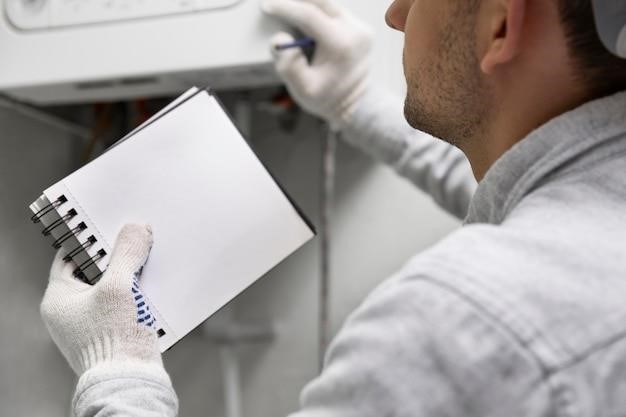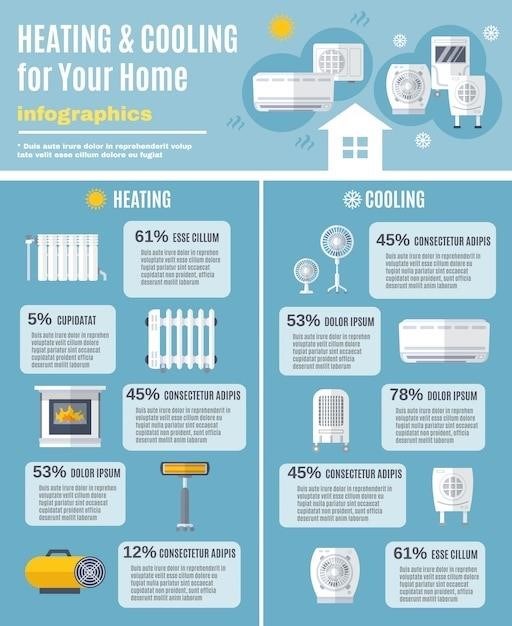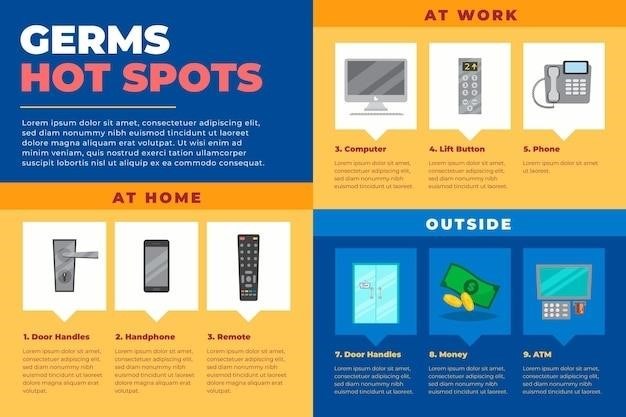This comprehensive guide assists in diagnosing and resolving common Pioneer mini-split issues. From power problems and sensor malfunctions to refrigerant leaks and error code interpretations, find solutions here. Learn about preventative maintenance and when professional help is needed.
No Power Issues
If your Pioneer mini-split system refuses to power on, systematically check the power supply. Begin by verifying the connection to the wall outlet; ensure it’s securely plugged in and the outlet itself is functioning correctly. A simple test is to plug another appliance into the same outlet to rule out a power issue at the source. Next, inspect your home’s circuit breaker panel. Locate the circuit breaker controlling the mini-split’s power and check if it’s tripped. A tripped breaker will be in the “off” position; switch it back to the “on” position. If the breaker immediately trips again, there might be a more serious electrical fault within the system, and professional assistance is recommended to avoid further damage or risk of electrical shock.
If the circuit breaker isn’t the problem, and the outlet is working, the issue might lie within the mini-split’s internal electrical components. This could include a faulty power cord, a malfunctioning control board, or a problem with the compressor motor. In such cases, attempting DIY repairs without proper electrical knowledge is strongly discouraged. Contacting a qualified HVAC technician is the safest and most effective course of action to identify and resolve the underlying electrical fault. They possess the expertise and specialized tools to safely diagnose and repair the problem, preventing further complications and ensuring the safe operation of your mini-split system.
Sensor Malfunctions
Pioneer mini-split systems rely on various sensors to monitor temperature, airflow, and other operational parameters. Malfunctioning sensors can lead to inaccurate readings, resulting in inconsistent heating or cooling, or even system shutdowns. A common culprit is the temperature sensor, either inside or outside the unit. If your mini-split is cycling on and off frequently, or isn’t reaching the set temperature, a faulty sensor could be the cause. To check the resistance of a Pioneer temperature sensor, you’ll need a multimeter capable of measuring resistance. Consult your mini-split’s manual or online resources for instructions on accessing the sensor and obtaining its correct resistance value. A significant deviation from the specified resistance usually indicates a malfunctioning sensor.
Diagnosing sensor problems often requires technical expertise. While some basic checks can be performed, such as visually inspecting sensors for damage or loose connections, more in-depth diagnostics and repairs typically require the skills of a qualified HVAC technician. They have the tools and knowledge to test sensors accurately, identify the faulty component, and safely replace it. Attempting to repair sensors yourself could lead to further damage or inaccurate repairs, potentially jeopardizing the system’s efficiency and safety. Professional repair ensures your mini-split operates optimally and safely. Remember, safety is paramount when dealing with electrical components and refrigerant systems.
Refrigerant Leaks
Refrigerant leaks are a serious issue in Pioneer mini-split systems, impacting cooling and heating efficiency and potentially damaging the compressor. Low refrigerant levels can cause the system to freeze up, cycle erratically, or fail to reach the desired temperature. Detecting leaks requires careful inspection of the entire system, including the copper tubing, connections, and components. Look for signs of oil stains, frost, or bubbling near joints or connections. A hissing sound might indicate a leak, but this is not always audible. If you suspect a refrigerant leak, do not attempt to repair it yourself. Refrigerant handling requires specialized equipment and training due to its potential hazards. Improper handling could lead to personal injury or further damage to the system.
Professional HVAC technicians possess the necessary tools to detect refrigerant leaks accurately. They use specialized equipment such as electronic leak detectors to pinpoint the exact location of the leak, even small ones that may be difficult to detect visually. Once identified, the technician can repair the leak by replacing damaged sections of tubing, sealing faulty connections, or replacing damaged components. After repairing the leak, the system requires recharging with the correct amount and type of refrigerant. Incorrect refrigerant levels or types can severely damage the system. Only a qualified technician should handle refrigerant recharge to ensure the system operates safely and efficiently. Ignoring a refrigerant leak can lead to more extensive and costly repairs in the long run. Addressing the problem promptly is essential for maintaining the system’s performance and longevity.

Error Code Troubleshooting
Pioneer mini-split systems utilize error codes displayed on the indoor unit to signal operational problems. These codes provide valuable clues for troubleshooting. Understanding these codes is crucial for effective problem-solving. The first step is to locate your system’s specific error code manual or consult the online resources provided by Pioneer. This manual details each code’s meaning and suggested troubleshooting steps. Common error codes often relate to communication issues between the indoor and outdoor units (e.g., E1), refrigerant problems, sensor malfunctions, or compressor issues. Once you identify the error code, consult the manual for guidance. Simple solutions may involve checking power connections, cleaning filters, or resetting the unit.
More complex issues might require deeper investigation. For example, an error code indicating a sensor malfunction might necessitate replacing a faulty temperature sensor. Refrigerant-related error codes may point to leaks requiring professional attention. Do not attempt complex repairs without proper training and equipment. Incorrectly handling electrical components or refrigerant can be dangerous. If the troubleshooting steps in the manual fail to resolve the issue, contact a qualified HVAC technician. A technician can properly diagnose the problem, perform necessary repairs, and ensure the system’s safe operation. Attempting advanced repairs without expertise may damage the unit further, leading to higher repair costs. Remember, safety is paramount. Always prioritize professional help when dealing with complex technical issues.
Understanding Error Codes
Pioneer mini-split systems employ error codes as a diagnostic tool, providing valuable insights into malfunctions. These codes, displayed on the indoor unit’s control panel, represent specific problems within the system. Each code corresponds to a particular issue, ranging from simple fixes like a clogged filter to more complex problems needing professional attention. The codes are usually alphanumeric (e.g., E1, F6, P01), and their meanings are documented in your unit’s user manual or can be found on Pioneer’s online support resources. Understanding these codes enables efficient troubleshooting; For instance, a code indicating a communication failure between the indoor and outdoor units directs you towards checking connections and wiring. A code signaling a refrigerant issue suggests examining for leaks and potentially requiring a recharge by a certified technician. Don’t attempt to interpret codes without referring to your model’s specific manual. Codes can vary across models, and incorrect interpretation can lead to wasted time and effort.
Before attempting any repairs, always consult the manual. It outlines troubleshooting steps for each code and explains the potential causes. Following these steps systematically helps pinpoint the problem and often leads to simple solutions, saving you time and potentially avoiding costly service calls. If the manual’s troubleshooting suggestions don’t resolve the issue, contacting a qualified HVAC technician is recommended. Professionals possess the expertise and equipment to diagnose and repair complex problems, ensuring the safety and efficiency of your mini-split system. Remember, always prioritize safety when dealing with electrical appliances and refrigerant systems.
Common Error Codes and Solutions
While specific Pioneer mini-split error codes vary by model, some common issues and their potential solutions include⁚ An “E1” code often indicates a communication problem between the indoor and outdoor units. Check all wiring connections for tightness and proper seating, ensuring no loose or damaged wires. If the problem persists, a faulty control board might be the culprit, requiring professional assessment. An “F6” error frequently signals a refrigerant issue, possibly due to a leak. Inspect refrigerant lines for any visible leaks. A low refrigerant level necessitates a professional recharge, as improper handling can be dangerous. A “P01” error code often points to a sensor malfunction. Check the temperature and other sensors for proper connections and functionality. A faulty sensor might need replacement. Remember, always consult your specific model’s manual for accurate code interpretations. The manual provides detailed explanations and troubleshooting steps tailored to your unit’s design. Many manuals include flowcharts guiding you through a systematic diagnostic process.
For errors related to the compressor, blower motor, or other internal components, professional help is usually required. Attempting repairs on these parts without proper training and tools can be dangerous and may void warranties. Simple issues like a clogged air filter can often mimic more serious problems, so always start with the easiest checks first. Clean or replace air filters regularly to ensure optimal performance and prevent potential error codes. Regular maintenance can also prevent many common issues and extends the lifespan of your mini-split system, reducing the likelihood of encountering error codes in the future. If you’re uncertain about any troubleshooting step, or if the problem persists after attempting basic solutions, contact a qualified HVAC technician for assistance.
Troubleshooting Specific Error Codes (e.g., E1, F6)
Let’s delve into troubleshooting specific Pioneer mini-split error codes. An “E1” error typically signals a communication failure between the indoor and outdoor units. Begin by checking all wiring connections for security and any signs of damage. Ensure that all wires are firmly seated in their respective terminals. A loose connection can disrupt communication. If wiring appears sound, the issue might lie within the control board itself, requiring professional inspection and potentially replacement. The “F6” error code often points towards refrigerant-related problems, commonly a leak. Carefully examine all refrigerant lines for any signs of leakage—look for discoloration, frost, or refrigerant escaping. If a leak is detected, professional assistance is essential for safe repair and proper refrigerant recharging. Attempting to handle refrigerant yourself can be dangerous. Other codes may indicate issues with specific components like the compressor, fan motors, or sensors. Refer to your user manual for detailed explanations and troubleshooting guidance specific to your Pioneer mini-split model. The manual usually provides step-by-step instructions and may include flowcharts to aid in diagnosing the issue. Remember that error codes can vary between models, so always consult the correct manual for your unit. If you are uncertain about any step in the troubleshooting process, it’s best to contact a qualified HVAC technician to prevent further damage or safety hazards. Professional assistance ensures a proper and safe repair.
Maintenance and Prevention
Regular maintenance is crucial for extending the lifespan of your Pioneer mini-split system and preventing costly repairs. A clean system operates more efficiently and reliably. Begin by inspecting and cleaning the air filter regularly, as recommended in your owner’s manual. A clogged filter restricts airflow, reducing cooling and heating effectiveness and potentially straining the system’s components. Dirt and debris can accumulate on the indoor and outdoor coils, impacting heat transfer. Inspect and clean these coils as needed, carefully following the manufacturer’s guidelines. Avoid using harsh chemicals that could damage the coils’ delicate fins. Check for any signs of refrigerant leaks, such as frost or unusual noises. Refrigerant leaks require professional attention. Inspect all electrical connections and wiring for any signs of damage or loose connections. Ensure that the outdoor unit is free from obstructions that could restrict airflow or cause overheating. Trim back any overgrown vegetation around the unit and keep it clear of debris. Regular maintenance not only prolongs the system’s life but also improves energy efficiency, saving you money on your energy bills. Consider scheduling annual professional maintenance checks. A qualified HVAC technician can inspect all system components, identify potential issues early, and perform necessary cleaning and adjustments. Preventive maintenance is far more cost-effective than emergency repairs. By following these simple maintenance steps, you can enjoy years of reliable and efficient climate control from your Pioneer mini-split.
Regular Maintenance Schedule
Establishing a regular maintenance schedule for your Pioneer mini-split system is key to ensuring its longevity and optimal performance. Create a checklist to track your maintenance tasks and their completion dates. Begin with monthly checks of the air filter. Inspect it for dirt and debris; replace or clean it as needed, depending on the filter type and usage. Every three months, conduct a more thorough inspection. Check the indoor and outdoor coils for dirt and debris buildup. Gently clean the coils using a coil cleaning brush and vacuum. Avoid using high-pressure water, which can damage the delicate fins. Annually, schedule a professional inspection and maintenance service. A qualified HVAC technician will inspect all components, including the compressor, refrigerant lines, and electrical connections. They can identify any potential issues before they escalate into costly repairs. During the annual service, the technician will clean the coils thoroughly, check refrigerant levels, and lubricate moving parts as necessary. This comprehensive annual service ensures your system operates at peak efficiency and helps to prevent premature failure. Keep detailed records of all maintenance performed, including dates, services performed, and any issues identified. This record will be invaluable if you encounter problems or need to make warranty claims. By following a consistent maintenance schedule, you’ll minimize the risk of breakdowns, extend the lifespan of your Pioneer mini-split, and ensure consistent, comfortable climate control throughout the year. Remember to always consult your owner’s manual for specific recommendations and safety precautions.

Advanced Troubleshooting Steps
If basic troubleshooting steps fail to resolve your Pioneer mini-split issues, more advanced techniques may be necessary. These steps require a deeper understanding of HVAC systems and may involve working with electrical components, so caution is advised. If you’re not comfortable performing these tasks, it’s best to consult a qualified HVAC technician. One advanced troubleshooting step involves checking the refrigerant levels. Low refrigerant levels can significantly impact cooling or heating performance. This requires specialized equipment and knowledge to safely measure and recharge the system; improper handling can be dangerous. Another advanced step is testing the compressor. The compressor is a vital component that circulates the refrigerant. Testing involves measuring voltage and current to ensure it’s operating correctly. Faulty compressors often require professional replacement due to safety concerns and specialized tools. Furthermore, inspecting the wiring and electrical connections is crucial. Loose or damaged wiring can lead to malfunctions. Use a multimeter to check for continuity and proper voltage readings at various points in the system’s electrical circuit. Always ensure the power is disconnected before working with any electrical components. Finally, consider the control board. The control board governs the operation of the mini-split. Testing involves visually inspecting the board for any signs of damage, such as burnt components or loose connections. Replacing the control board often requires specialized knowledge and tools, making professional assistance highly recommended. Remember, safety is paramount. If you’re not comfortable performing these advanced troubleshooting steps, contact a qualified HVAC technician to prevent further damage or injury.
